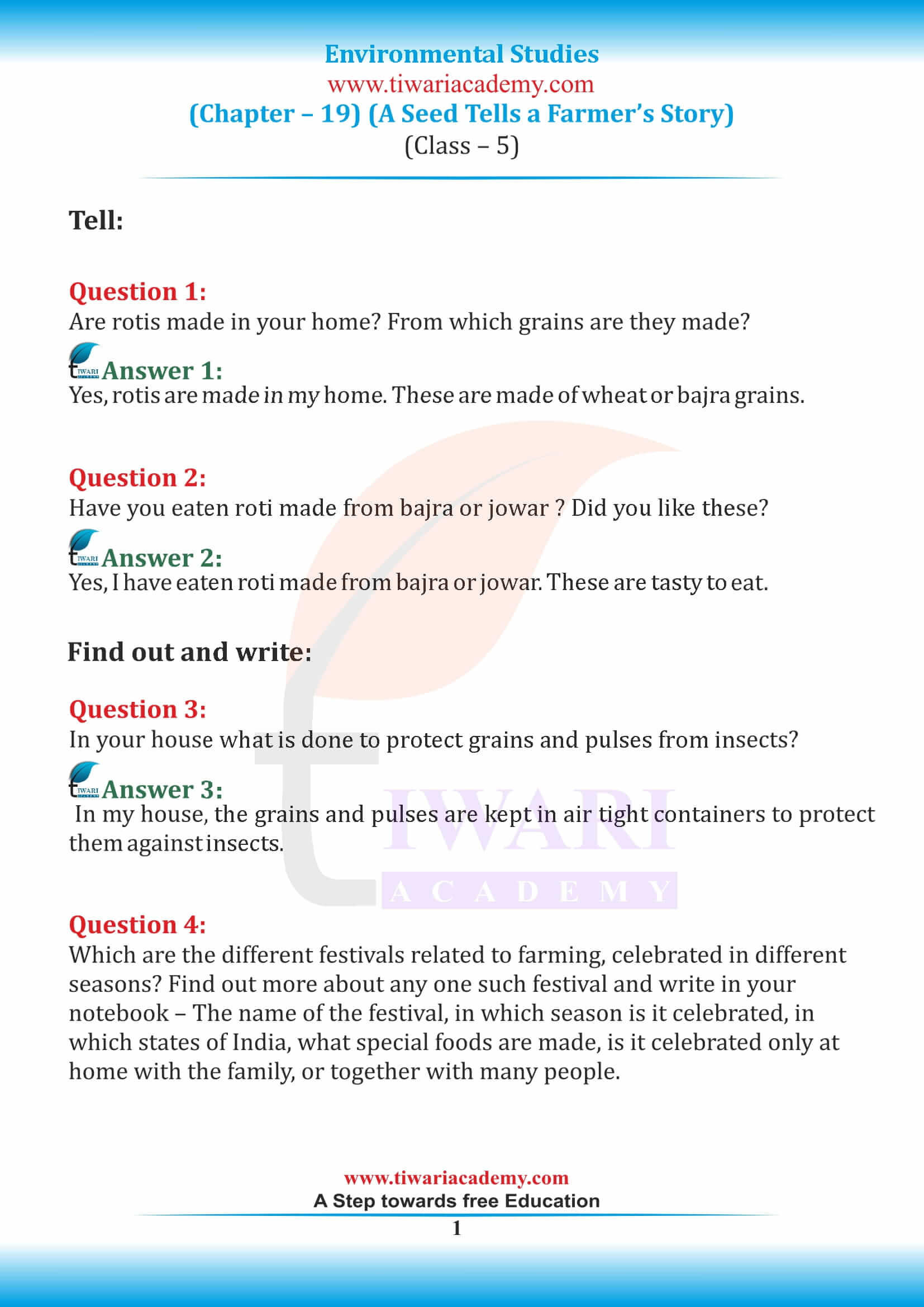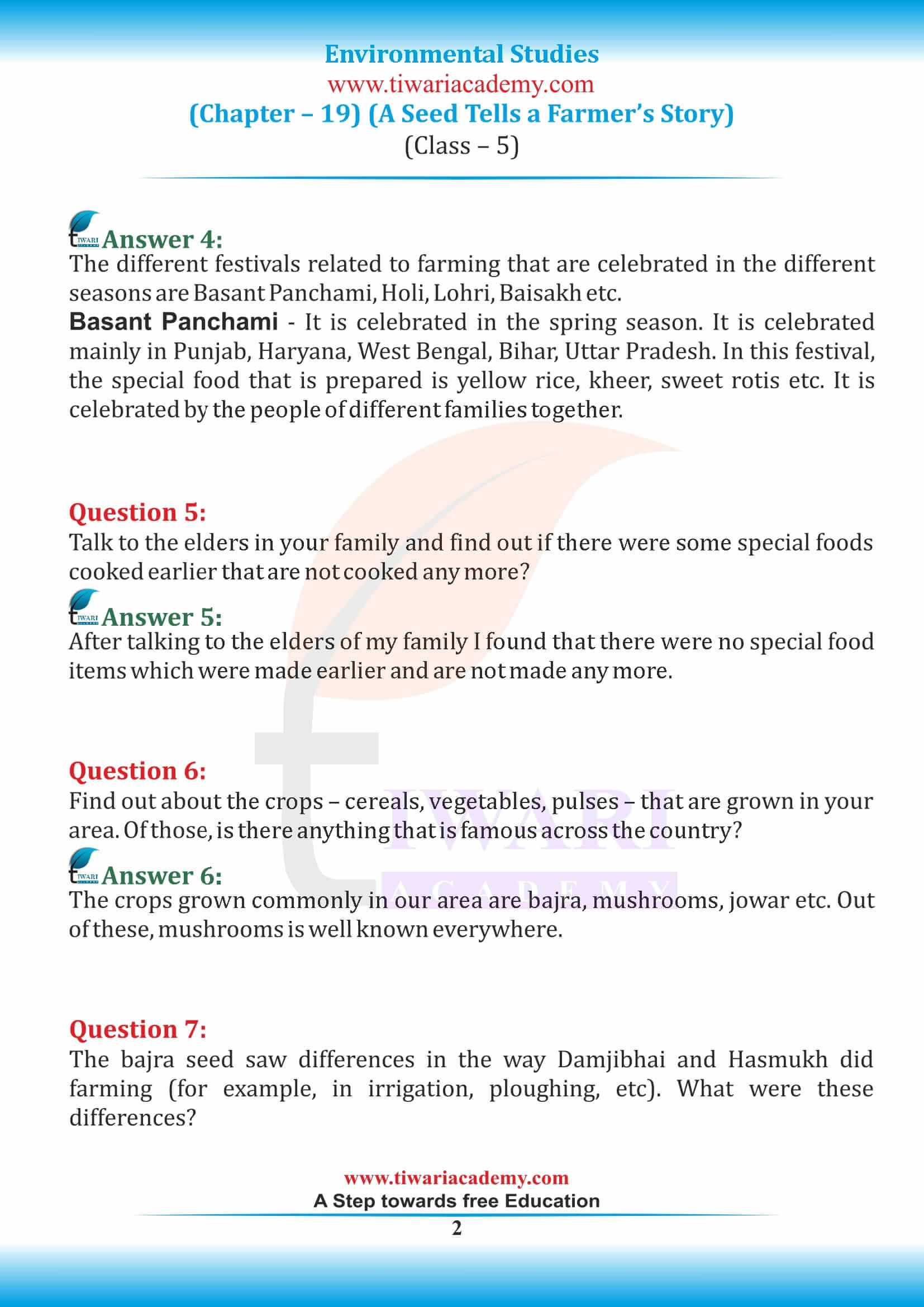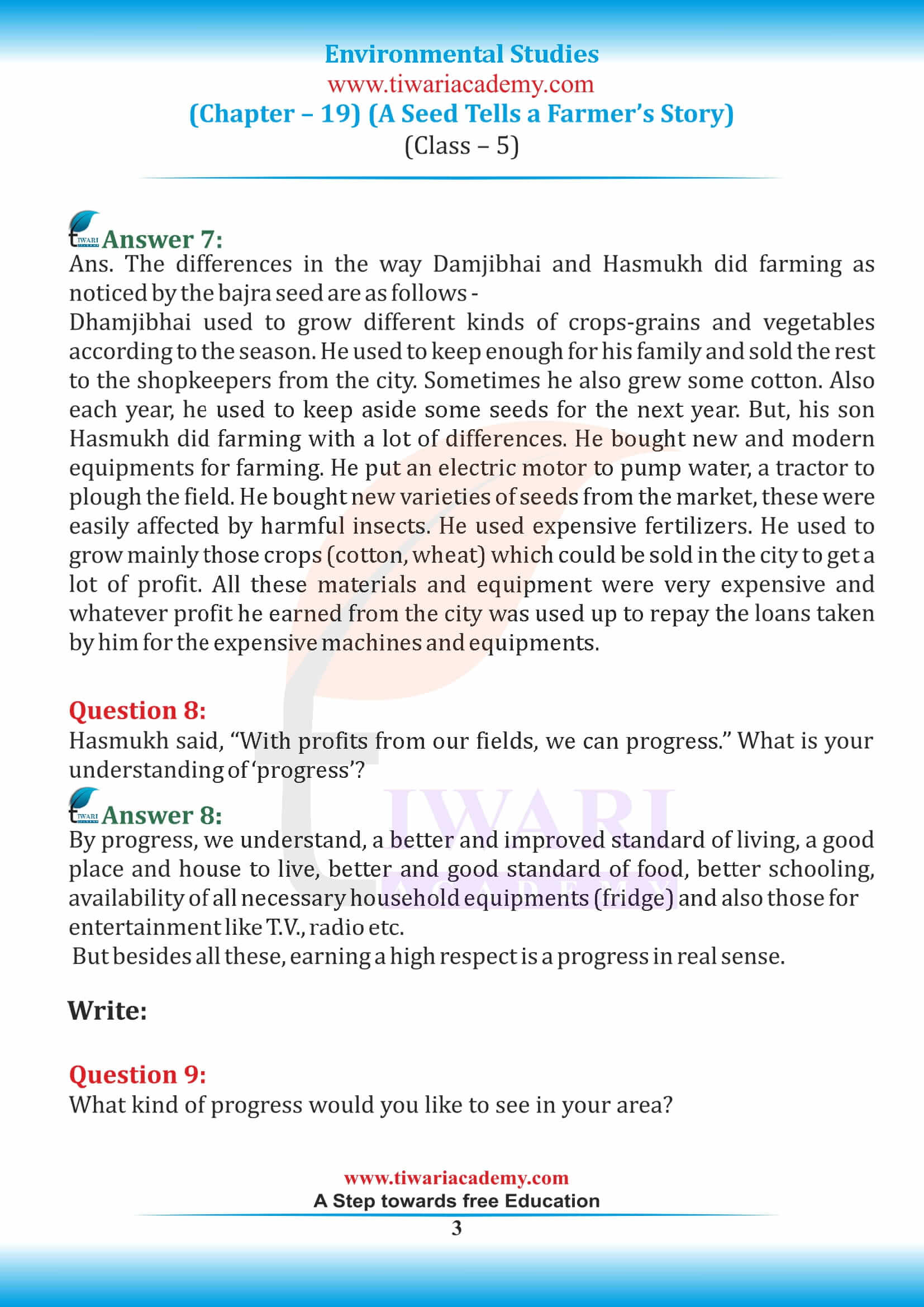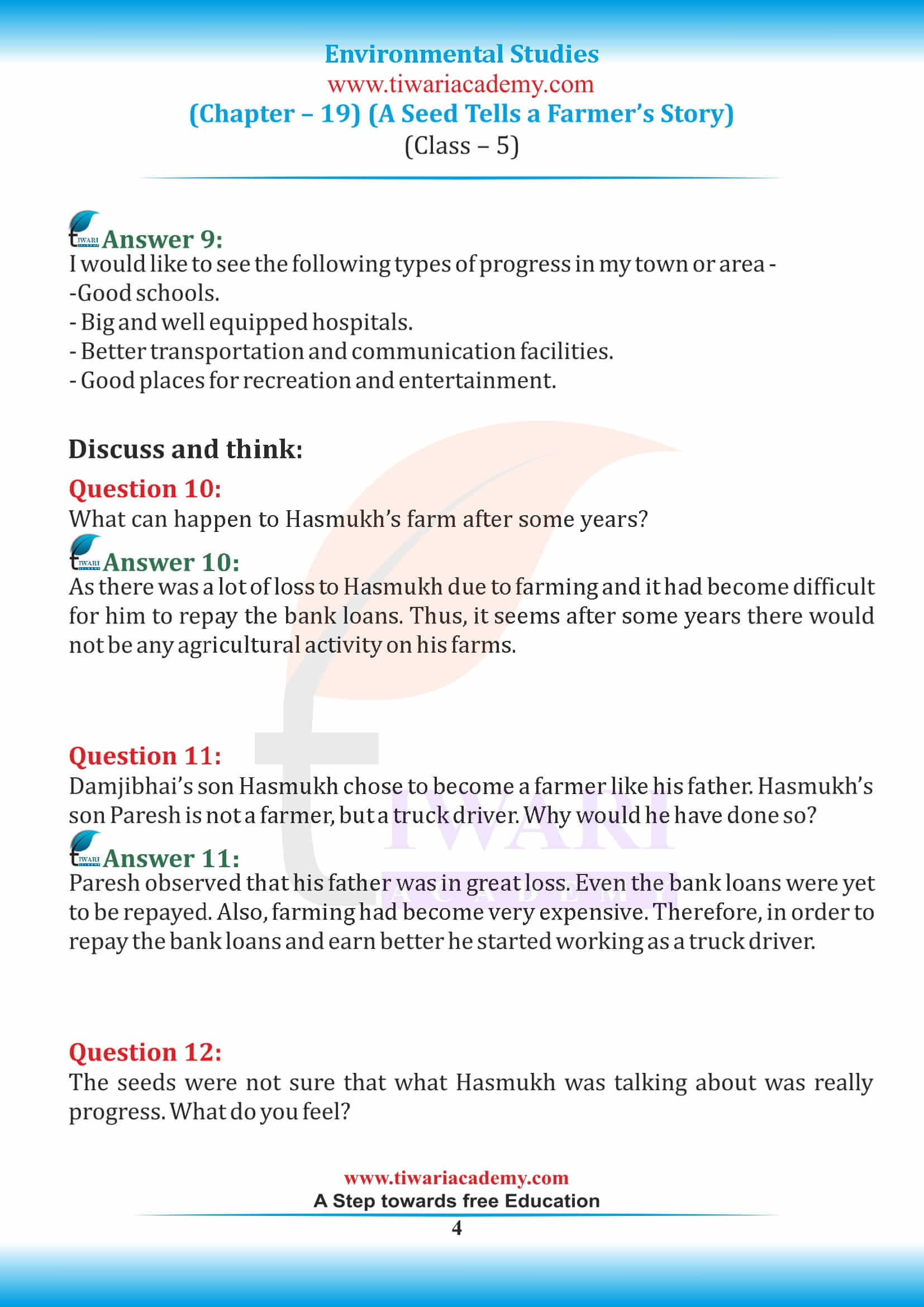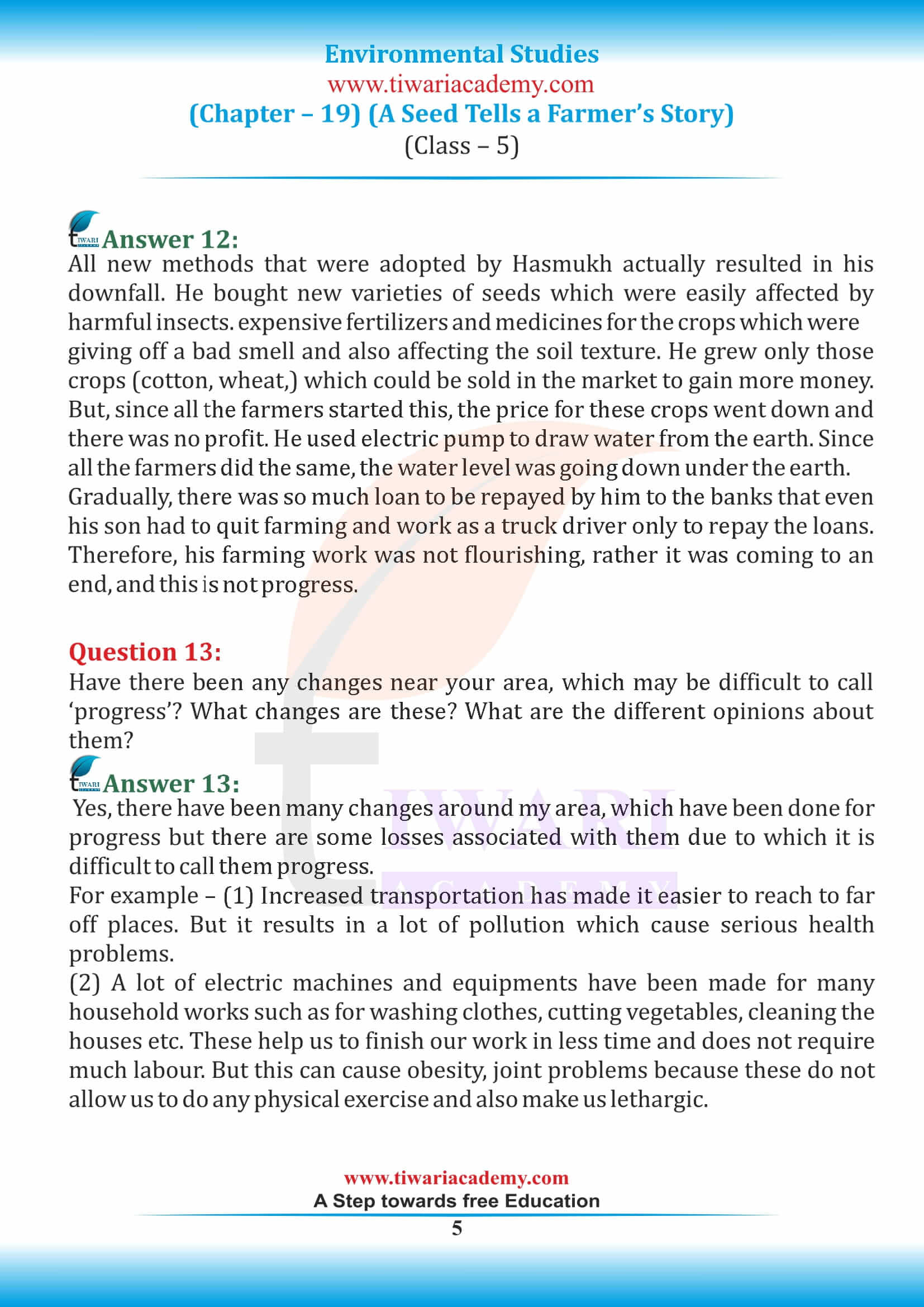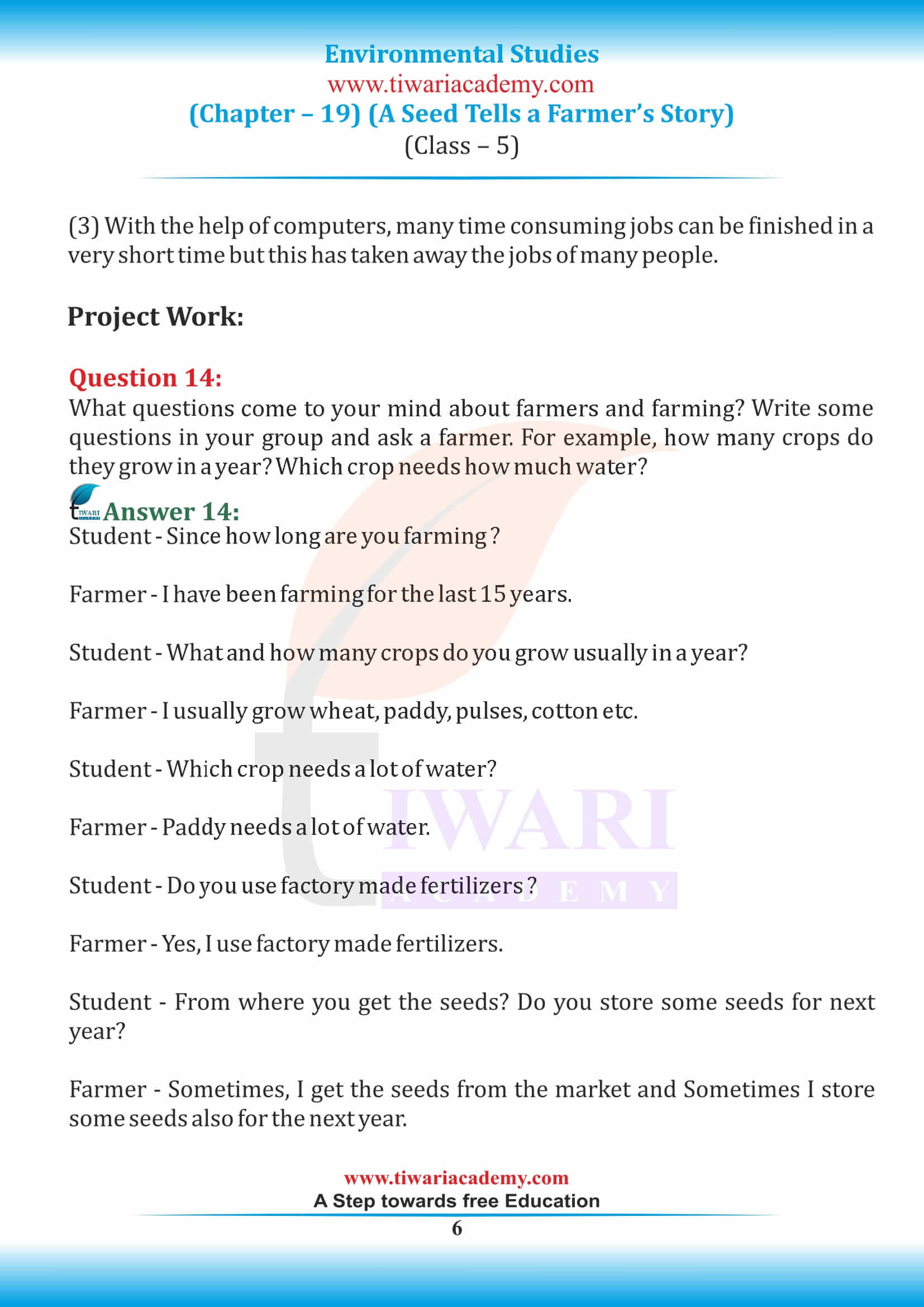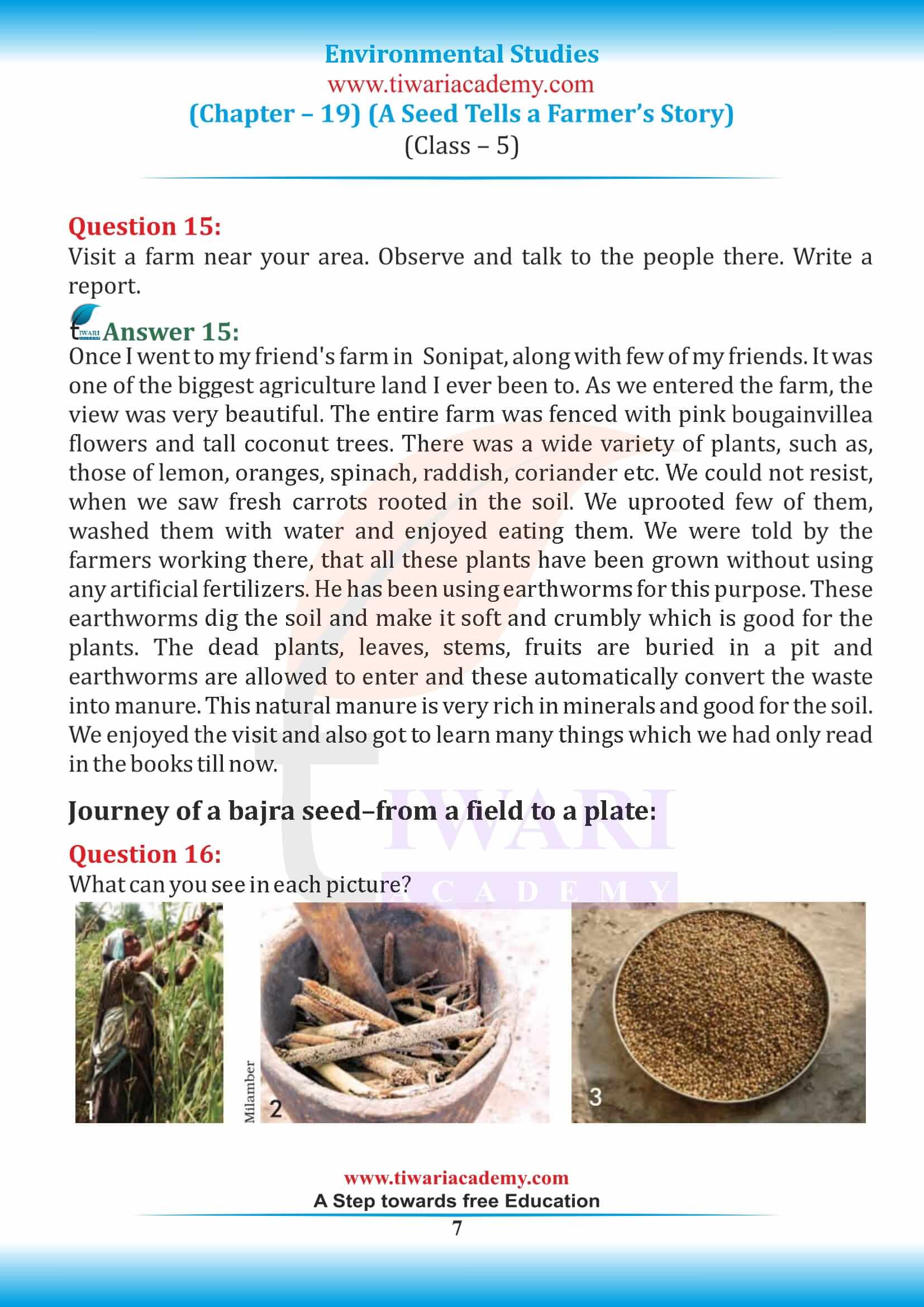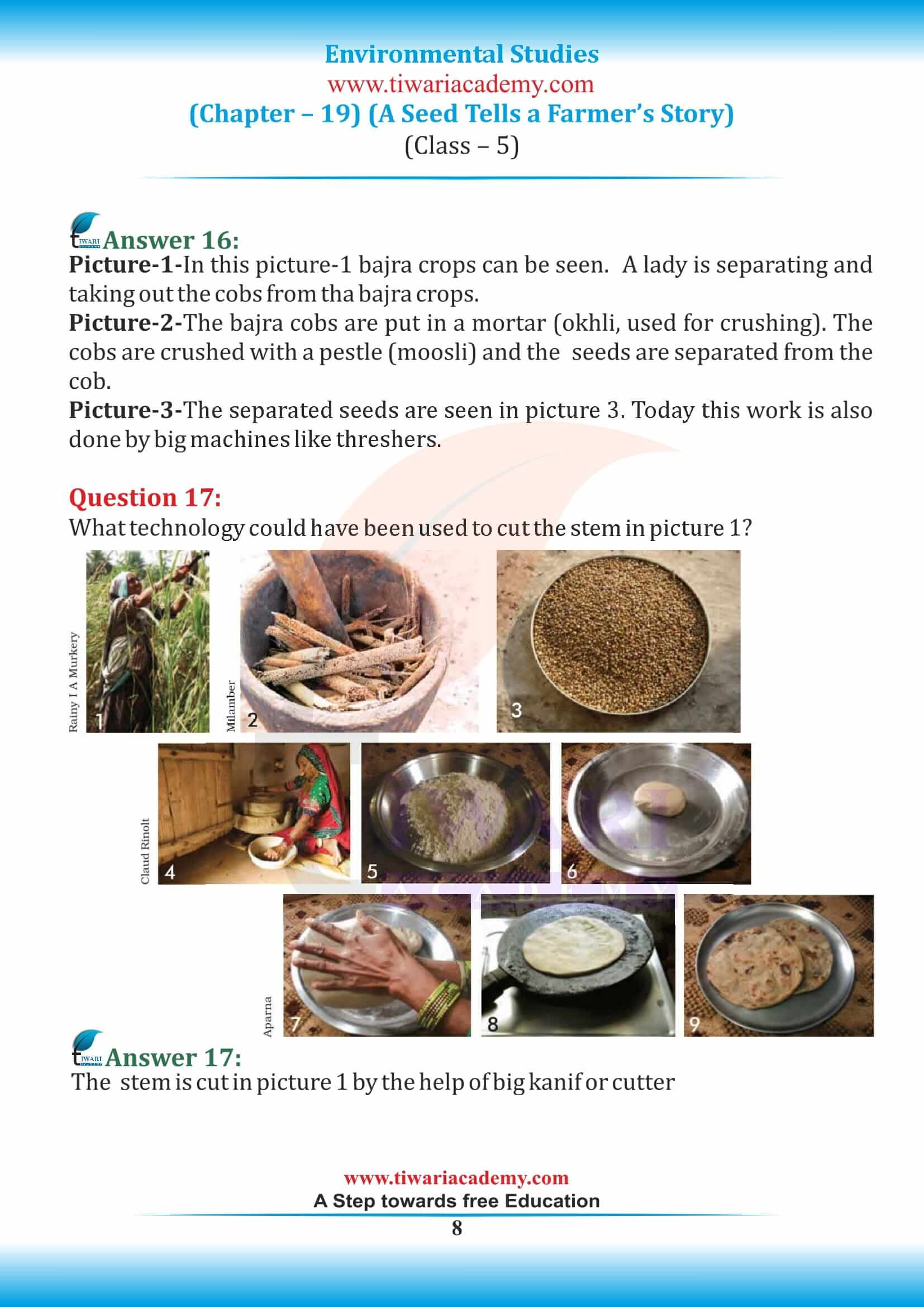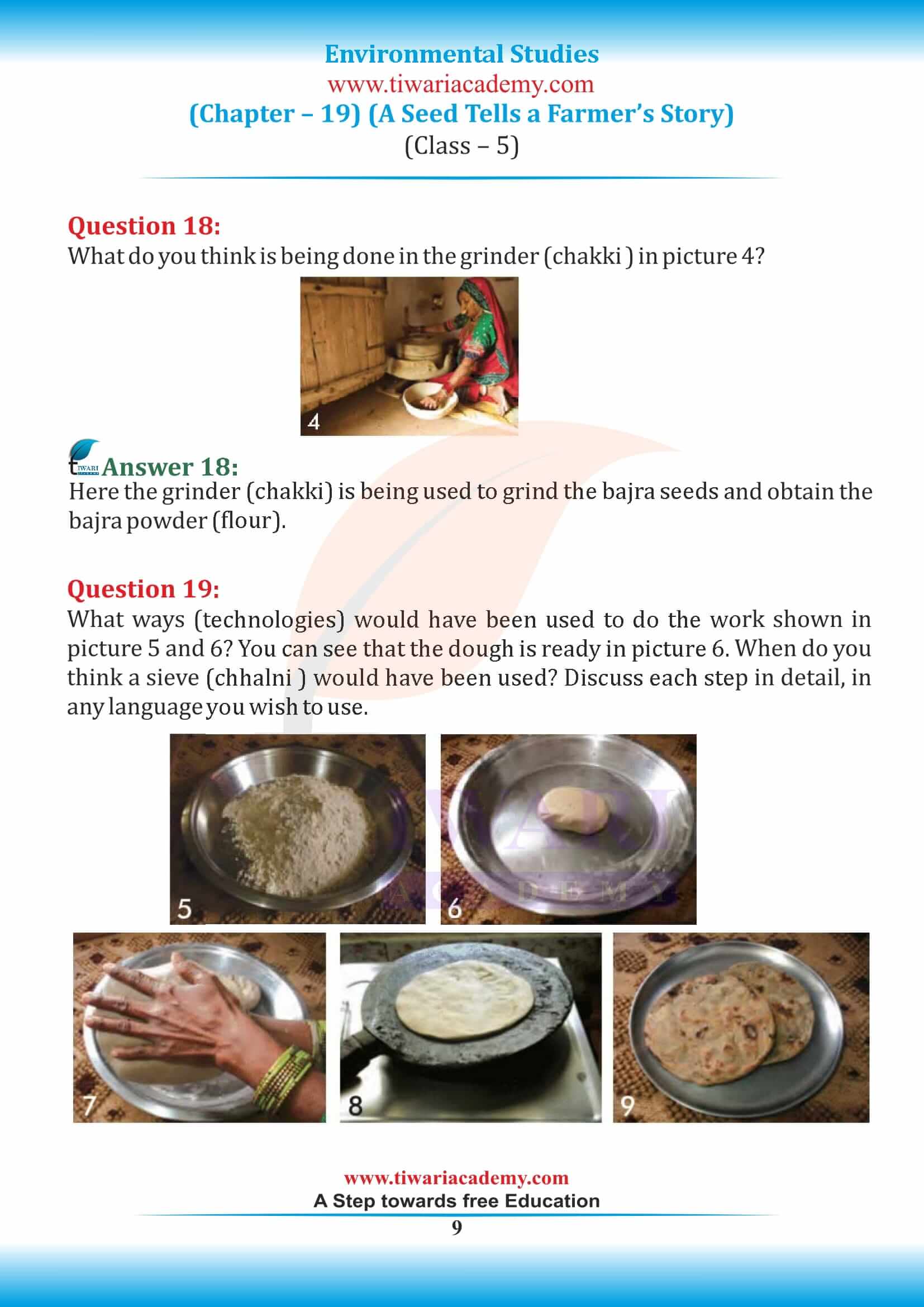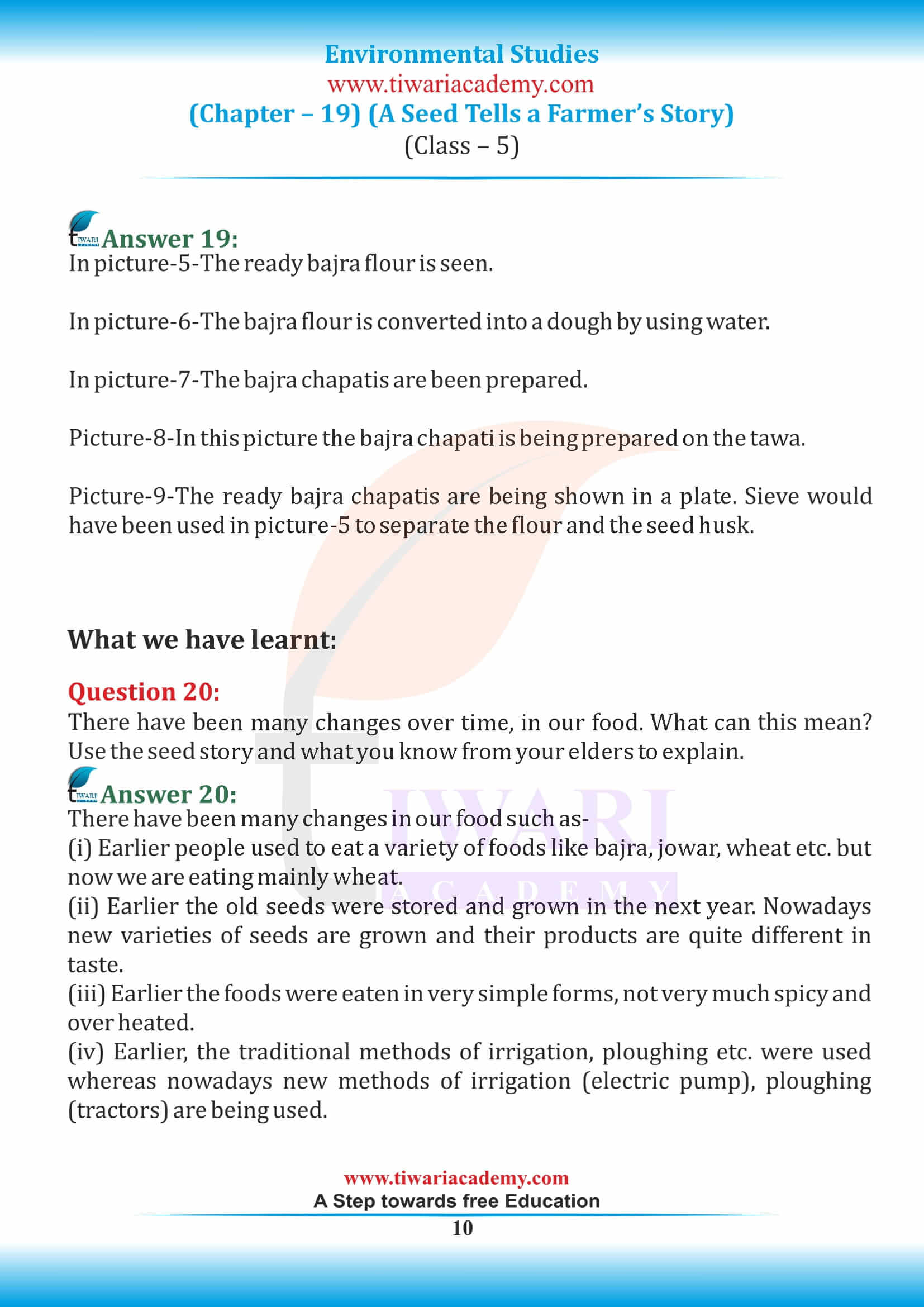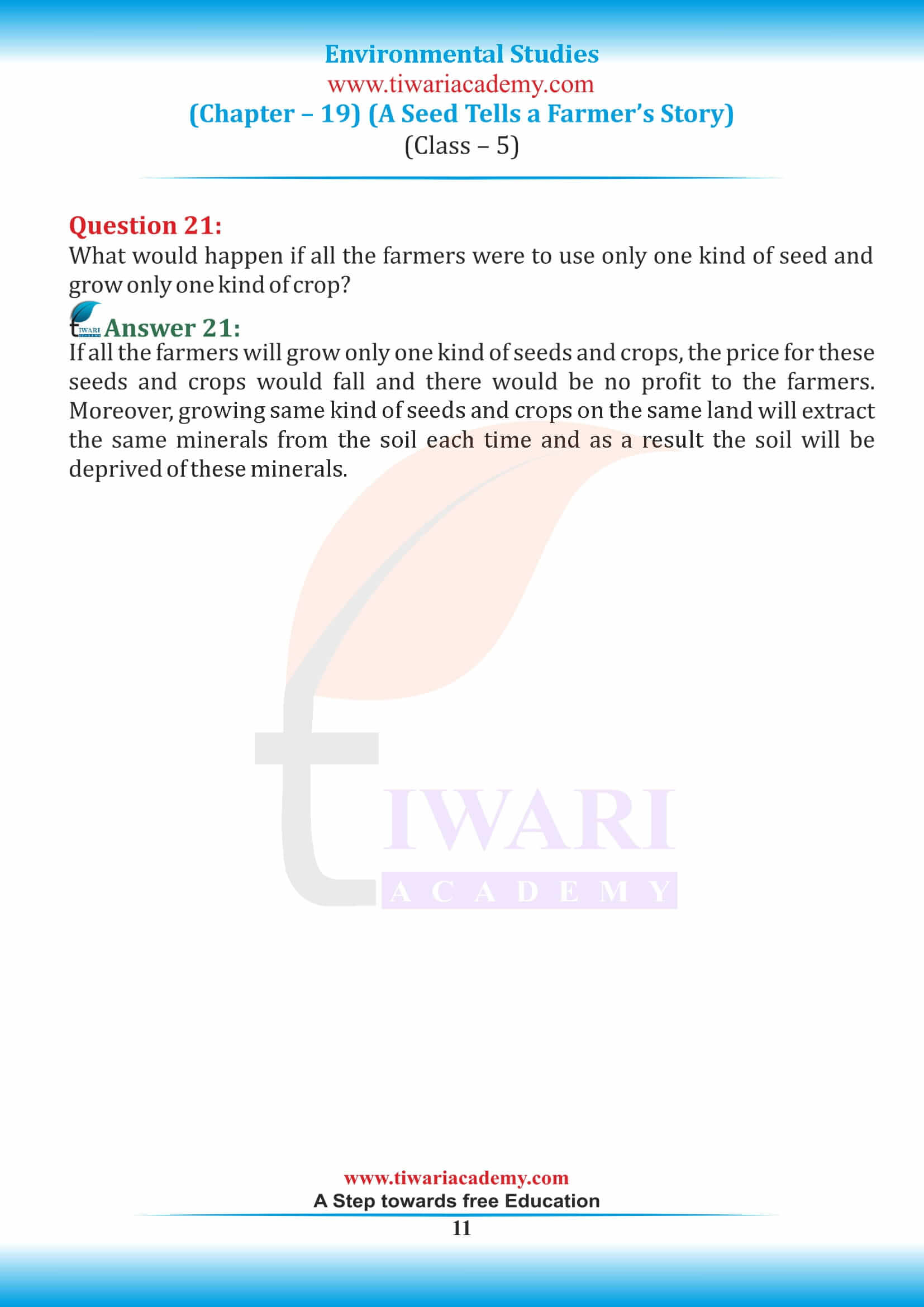NCERT Solutions for Class 5 EVS Chapter 19 A Seed tells a Farmer’s Story in Hindi and English Medium for session 2024-25. All questions answers, solutions of exercise questions, extra questions based on NCERT Chapter 19 of 5th EVS. In chapter 19 of grade 5 EVS, we will learn about Seeds and how are they grown by the farmers. Revise the entire chapter using extra questions with explanation. These extra questions are very important for exams also.
NCERT Solutions for Class 5 EVS Chapter 19
Class 5 EVS Chapter 19 Question Answers of A Seed tells a Farmer’s Story
Class 5 EVS Chapter 19 Question Answers Set 1
Who was Damjibhai?
Damjibhai was a farmer. He followed traditional methods of farming and used bullocks to plough the field. He stored the grains to be used as seeds
What did Damjibhai do to protect seeds from insects?
Every year good seeds were stored in dried gourd (lauki) which was coated with mud. But now Damjibhai made a strong wooden box to store seeds. He put different seeds in different compartments of the box and also put neem leaves in them to protect the seeds from insects.
Why was there festive mood in the village?
Damjibhai and his cousins lived together. It was a large family. Everyone in the village helped each other, even in farming. When the crop was ready and harvested, everyone celebrated together with big feasts and lots to eat. That year there was a good bajra (millet) crop that is why there was festive mood in the village.
What is undiya?
In the winter, it would be time to enjoy the undhiya which is a kind of stew. All the vegetables were
put into a clay pot, along with fresh spices. The pot was sealed and kept between hot coals. The vegetables cooked slowly in this special cooker on the fields. The pot was placed upside down. That is why the dish was called undhiya or “upside down” in Gujarati. Undhiya would be eaten with bajra rotis, freshly cooked on the chulha. Home-made butter, curd and buttermilk were served with it.
Which plant gives signal when the soil becomes dry?
Plants like crotons give clear signal about the dryness of soil. These plants do not have very deep root and as the result they collect water from the first layer of the soil. When the soil gets dry these plants can’t suck water from the surrounding layers and tend to get dry. These plants provide the first signal that the soil has turned dry.
Class 5 EVS Chapter 19 Question Answers Set 2
What does a farmer do with his crops?
A Farmer grows different kinds of crops, grains and vegetables according to the season. They keep enough for their needs and sell the rest of the crops to the shopkeepers from the city. Some farmers also grew cotton. And then at home, the entire family would spin cotton on a charkha (spinning wheel) to make cloth.
How did the farmers increase the fertility of soil in olden days?
Earth worms and termites helped to increase soil health. In the olden days, after the harvest, the top portion of the crop was used for human consumption, the middle portion was used as a feed for animals and the bottom portion went back to the soil and supported the growth of microorganisms, which made the soil fertile. The farmers also used methods like crop rotation and inter cropping to restore soil fertility. Mixed or inter cropping with legumes in cereal and oil seed cultivation were widely used practices.
Why are earthworms considered a farmer’s friend?
Earthworms are known as farmers’ best friends because they help the farmers by improving the fertility of soil and thus the plant health. They help to increase the amount of air and water that gets into the soil. They break down the organic matter, like leaves and grass into things that plants can use. When they eat, they leave behind castings that are a very valuable type of fertilizer.
Question:
How do the farmers improve the quality of the soil?
Answer:
The farmers improve the quality of the soil by:
- increasing soil protection by crop residues and plants.
- adding organic matter to the soil.
- through crop rotations.
- manures, or crop residues;
- careful use of fertilizers and pesticides,
- ploughing method, and other elements of the farming system can improve soil quality.
Class 5 EVS Chapter 19 Question Answers Set 3
What are fertilizers?
Fertilizers are the chemical substances that are supplied to the crops to increase their productivity. The fertilizers contain the essential nutrients required by the plants, including nitrogen, potassium, and phosphorus. They improve the water retention capacity of the soil and also increase its fertility.
What are pesticides?
Pesticides are the chemical substances that are meant to kill pests. The most commonly pesticides are:
• insecticides to kill insects,
• herbicides to kill weeds,
• rodenticides to kill rodents,
• fungicides to control fungi, mould, and mildew.
What are organic fertilizers?
Organic fertilizers are the natural fertilizers that are obtained from plants and animals. Organic fertilizers increase the organic matter content of the soil, promote the reproduction of microorganisms, and change the physical and chemical properties of the soil. It is considered to be one of the main nutrients for green food.
What replaced the crops like Bajra and Jowar and why?
Bajra and Jowar were the crops that were grown by the farmers. With the coming of the new technology, many changes occurred Bajra and jowar were soon replaced by the cotton crops and wheat as the farmers were getting good prices in the market for such crops.
What is vermiculture?
Vermiculture is the artificial rearing or cultivation of earthworms and using them for the betterment of human beings. This artificial rearing of worms involves the decomposition of organic food wastes into nutrient-rich material.
What is a compost pit?
A compost pit is the hole dug in the garden or park for dumping the biodegradable substances in it so that they decay and form manures and produce fertile substances for the soil.
Why is a compost pit important?
A compost pit is important as it provides many essential nutrients for plant growth and therefore is often used as fertilizer. Compost also improves soil structure so that soil can easily hold the correct amount of moisture, nutrients and air.
Question:
What are the various steps involved in agriculture?
Answer:
The various steps involved in agriculture are-
• preparation of soil,
• sowing,
• adding manure and fertilizers,
• irrigation,
• harvesting and
• storage.
Class 5 EVS Chapter 19 Question Answers Set 4
Why is it not good for the soil to grow the same crop throughout the year?
It is not good for the soil to grow the same crop throughout the year because if the same crop is grown continuously throughout the year, then the soil loses its fertility. This happens because the plant drains the same nutrients from the soil every year. This leads to deficiency or depletion of the nutrients and soil infertility.
What would happen if the farmers were to use only one kind of seed and grow only one kind of crop?
If the farmers were to use only one kind of seed and grow only one kind of crop there will be following problems:
• There will be no variety of foods.
• It will also harm the soil as the soil will lose its fertility.
• There will be a severe outbreak of diseases.
• The attack of insects on the plants will be more.
• Profit from agriculture will decrease every year.
How has farming become easier in modern times?
Farming has become easier dur to the following ways-
• the use of scientific methods.
• the use of modern machines such as tractors, harvesters, thrashers and combines which has made the agriculture easy and time saving.
• Use of new and latest technology and methods of farming
What are threshers? Ans:
Thresher is a machine that is used to separate grain from the crops by beating the cobs.
What is irrigation?
Irrigation is the process of providing water to the fields or crops artificially. It is a way to fulfil their water requirements. The various sources of water for irrigation are wells, ponds, lakes, canals, tube-wells and even dams. Irrigation provides water which is required for growth and development, germination of the plant.
What is crop rotation?
Crop rotation is the practice of planting different crops in a series on the same plot of land to improve the soil health, enhance nutrients in the soil, and fight pest and weed pressure. A simple rotation involves two or three crops.
Question:
Differentiate between traditional and modern methods of farming.
Answer:
Difference between traditional and modern methods of farming are given below:
| Traditional Farming | Modern Farming |
|---|---|
| In this method outdated and old methods of farming are used therefore it is known as traditional methods of farming. | New and scientific methods of farming are used nowadays which are known as modern methods of farming. |
| These methods are time consuming and production is also low. | These methods are quick, efficient and easy to used and lead to higher production in less time. |
| Old methods of farming like irrigating lands with the help of Persian wheels are used. | Machinery like tractors and threshers are used. |
| Traditional seeds are used. | HYV seeds, irrigation, chemical fertilizers, pesticides etc. are used. |
| Cow-dung and other natural manure are used as fertilizers. | Chemical fertilizers and pesticides are used. |
| Farmers are dependent on monsoon rain. | Farmers are not dependent on monsoon rain as they have provision of tube wells for irrigation. |
| Traditional farming methods do not require more inputs which are manufactured in industry. | Modern farming methods required more inputs which are manufactured in industry. |
Question:
What changes have come in agriculture in India over the years?
Answer: There were some significant changes in agriculture over the years:
• The farmers are no longer dependent on rain for watering their fields, there are alternative sources available for that like some places get water from the canal which gets water from dam that have been built on big rivers.
• Cows and bullocks have been replaced by tractors now
• New and good variety of seeds are available.
• Farmers have now started buying seeds from the market.
• Fertilizers and pesticides are sprayed on the plants to save them from insects
• Electricity is also available now
• Farmers do not need to store seeds from the old crop
• They are able to get loans from banks.
• They use new and modern equipment for farming.
• an electric motor to pump water
Class 5 EVS Chapter 19 Question Answers Set 5
What is the role of government in increased agricultural production?
The role of the government in increased agricultural production is that it:
• provides them with funds (loans) to buy the fertilizers, seeds and machinery.
• provides them with irrigational facilities
• buys their production by giving them surplus income
• provides them with HYV seeds for more better production
How do the farmers get water for their crops?
The different ways through which the farmers get water for their crops through canals, tube wells, hand pumps, step wells, rivers, ponds etc.
Why was replacing cows and bullocks not a correct decision?
Without cows and buffaloes, there was no cow dung, to be used in the fields as fertilizer. Hasmukh had to buy expensive fertilizer. The new kinds of seeds were such that the crops were easily affected by harmful insects. Medicines had to be sprayed on the crops to keep away the insects which had a bad smell and were too expensive.
What is the difference between natural and artificial fertilizers?
Natural fertilizers are organic products that have been extracted from living things or from the earth while chemical or artificial fertilizers are manmade or mined, they add nutrients to the soil.
Natural fertilizers improve the texture of the soil and increase the amount of beneficial microorganisms.
Why were the farmers of Andhra Pradesh sent to jail?
Farmers in Andhra Pradesh have been sent to jail as they were not able to pay back their loans. They had suffered a big loss in farming.
Who is a money lender?
A money lender is a person or a group who typically offers small personal loans at high rates of interest.
Which implements are used in agriculture?
There are a variety of implements used in the modern scientific agriculture but the most basic implements used in Indian agriculture are: Khurpi, sickle, spade, pickage, desi plough
Why were pesticides sprayed on the crop?
Pesticides are sprayed on the crops to control the various pests and disease carriers, such as mosquitoes, ticks, rats and mice. Pesticides are used in agriculture to control weeds, insect invasion and diseases.
Questions:
What were the major disadvantages of practicing modern farming methods?
Answer:
The major disadvantages of modern farming are-
• There is an excessive use of chemicals with the help of machines which reduces the fertility of the land.
• There is lack of practical knowledge as a result the farmers are unable to handle the machines properly.
• the cost of maintenance is very high.
• Overuse of machines may lead to environmental damage.
Class 5 EVS Chapter 19 Question Answers Set 6
What are the disadvantages of modern farming?
The disadvantages of modern farming are as follows-
• Quality of the seed decreases due to the use of hybrid varieties.
• Growing same type of crops in the same field makes the soil infertile and poor in mineral contents.
• Causes air pollution due to spraying of insecticides.
• Food crops sprayed with insecticides cause threat to human life causing diseases.
What are the things which are put in the compost? Ans.
The person puts dried leaves in the pit, along with all the kitchen waste, peels of vegetables and fruits like banana, roti and leftover food. All these things rot and mix with the soil. He also has earthworms in the pit. They turn the waste into compost which is a natural fertilizer.
What do you mean by Ploughing?
The process of loosening and turning the soil is called ploughing (tilling). Before sowing the seeds, it is necessary to loosen and turn the soil in the fields as to break it to the size of the grains which is done with the help of three main implements or tools to plough are hoe and cultivator.
What is a sickle?
Sickle is a curved iron blade which was an agricultural tool. It was used for reaping cereal crops at harvest time. The handle was probably made of wood or bone.
Why was it becoming difficult to earn a living by farming alone during those days?
The soil was no longer fertile. Moreover, growing the same crop over and over, and using so many chemicals, had affected the soil so much that now nothing could grow well there. As a result, it was becoming difficult to earn a living by farming alone.
Question:
What are advantages of using manures?
Answer:
The advantages of using manure are:
• it contains large quantities of organic matter and small quantities of nutrients.
• It increases the water holding capacity of sandy soil.
• It helps in draining out of the excess of water from the clayey soil.
• Reduced soil erosion and runoff.
What does this seed try to tell in chapter 19 of EVS book class 5th?
The seed Tells us the story of how the farmer developed from growing the crops for availability is now changed to growing crops for earning profits from the commercial point of view. Now the availability of seeds is easy not like the previous days when they had to save the seeds for coming year crops. People don’t eat together too much as the way of cooking has been changed.
As per seed in the story given in chapter 19 of class 5th EVS, what phase of development does it tell in the story?
The Seed trying to tell us about the development and what are the things that development has changed in few years, from people cooking in traditional Chulha to preparing meals on the stove and not saving the seeds instead of that buying the seed because of which the seeds kept with the leaves of Neem tree remained in the bag. Farmers are not growing the crops that benefit the health of the welfare and also taste good instead of that they’re growing to sell in the market to earn more.
This shows the good side of development as well as certain disadvantages of developments too.
Do you find the class 5th EVS chapter 19 providing good knowledge about society and development?
After reading chapter O found the story is giving the knowledge of growing crops and how the farmers kept the seeds to provide food in our plates. Not just that how the development changed everything and made things easy for the farmer s along with the negative effects on families too.
Which is why we can say this chapter is giving enough and apt knowledge about the farmer’s society.
